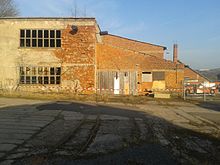Share brick Eisenach
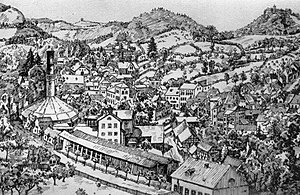
|
| The Eisenach brickworks with the Hoffmann ring oven |
|---|
| R. Bock , 1875 |
| Copper engraving |
| Eisenach, Marienstraße 1 (today: 21) |
The Eisenach share brickworks was a brick factory in Eisenach and Stregda , which at times was run as a public limited company . The Gerstungen brickworks was also temporarily part of the company. Even today there are numerous well-preserved houses built with bricks from the Eisenach production in Eisenach, especially in the southern part of the city and in the surrounding area.
Company history
Eisenach brickworks
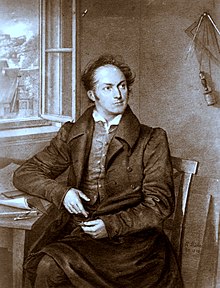
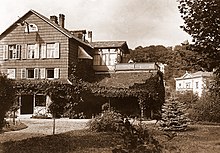
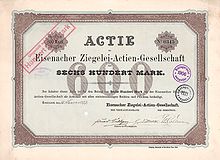
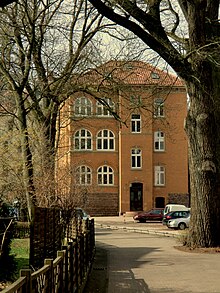
In 1820, the Grand Ducal Building Councilor Johann Wilhelm Sältzer founded the first Eisenach brickworks, which he built together with a residential building on his property south of the former city wall between Karthäuserstraße, now Wartburgallee, and Marienstraße. In 1827 he received a 20-year privilege from Grand Duke Carl August, which stipulated that no further brick factories were allowed to set up in the Eisenachischen Unterlande. This privilege was linked to the condition that Sältzer had to keep a stock of at least “50,000 pieces of brick in accordance with the regulations”.
"Carl August by the grace of God Grand Duke of Saxony, pp: It has been presented to us from the report of our regional directorate of March 21, 1827, what the Baurath Sältzer, in Eisenach, presented to his brick kiln in Eisenach and. what privilege he has asked for. After we have then resolved with grace to add to this request so far that from now until the end of 1847 in the Eisenachischen Unterlande, ie in the fifth district council, no new authorization to set up and operate a brick kiln is to be granted, however without prejudice to all the already existing authorizations and on the condition that the building councilor Sältzer will duly fulfill his promise to keep a supply of at least 50,000 pieces of brick according to the regulations; so we graciously instruct our state management to inform the Baurath Sältzer of this resolution of ours in order to reassure him and to assure him. Our will happens to this and we remain in favor of the state management. Weimar, April 13, 1827. Signed: Carl August, G. z. S. "
Hoffmann ring furnace
The brickworks expanded and from then on produced the bricks required for the development of the up-and-coming town of Eisenach. Around 1850, Johann Wilhelm Sältzer's son, the builder and architect Eduard Sältzer, took over the management of the brickworks. He recognized the value of Hoffmann's ring kiln , patented in 1859 , had one built four years later as the first in Thuringia on the property of the brickworks and, in conjunction with the inventor, contributed significantly to its spread. Many ring kiln owners from all over Germany received advice and instructions from Sältzer about the operation and treatment of the kiln, with which he could burn solid and semi-finished stones, drain pipes and roof tiles, gypsum, lime and cement without any problems. After the brickworks had taken a great boom, it was enlarged and transferred to the Eisenacher Actien brickworks under his management .
Drewes steam brick
On the northern outskirts of Eisenach and to the west of today's Stregda district on the northeast slope of the Moseberg , clay and clay deposits were developed from the 1830s to supply the nearby city with building materials. In 1838 the Stregda steam brickworks was founded on the southern outskirts of the village by entrepreneur H. Drewes.
Eisenacher Ziegelei-Aktien-Gesellschaft
In 1864 the geologist Johann Georg Bornemann founded the Eisenacher Ziegelei-Actien-Gesellschaft on Mühlhäuser Straße in the north of Eisenach. During the mining of clay near Stregda in the 1870s, extensive remains of a ribbon ceramic settlement were discovered and systematically exposed and examined by Johann Georg Bornemann. After the merger with the Eisenach brickworks Sältzer , the management of the Aktien-Gesellschaft passed to Eduard Sältzer until his death in 1880.
After the acquisition of the Gerstungen brickworks, the company traded as Klosterziegelei Eisenach-Gerstungen AG from 1909, based in Eisenach. In 1914 the management was relocated to Gerstungen. The beginning of the First World War caused a slump in sales, and numerous company employees were drafted into military service. After losses had been made since 1914, the liquidation of the company was up for discussion in 1916.
The factory in Gerstungen fell victim to a major fire in 1935, but was immediately rebuilt. In 1937, the joint brickworks bought the Stregda brickworks for 750,000 Reichsmarks, which it had already taken over management of in 1924.
VEB Thüringer Dachziegelwerke and closure
In 1953 the companies in Eisenach, Gerstungen and Stregda were nationalized and henceforth operated under the name VEB (K) Thüringer Dachziegelwerke.
After the fall of the Wall , the brickworks were shut down at all three locations. The plant in Mühlhäuser Strasse was completely demolished shortly afterwards and the site was rebuilt with a shopping center. The brick factory in Stregda has been preserved as a ruin; The Eisenach Arena leisure area was built on a partial area , which from 2005 to 2010 housed the nationally known MAD large-capacity disco .
Mine train
The clay pits and the factories in Stregda and Mühlhäuser Strasse were connected to each other from the end of the 19th century by an extensive track network of a narrow-gauge mine railway for the transport of materials, which became the factory in Eisenach until the end of the 1970s, between the clay pit and the factory Stregda operated until the late 1980s. Traffic to the Eisenach plant was interrupted in 1978 by the construction of the Eisenach-Nord residential area; operations between the clay pit and the Stregda plant were maintained until the end of operations in 1990.
Sources and literature
- Eduard Wolff senior: Eduard Sältzer † July 14, 1880 . In: Deutsche Töpfer- und Ziegler-Zeitung , No. 31 of July 31, 1880.
- Urania cultural and educational association Gotha eV (Ed.): Eisenacher personalities. A biographical lexicon. RhinoVerlag, Weimar 2004, ISBN 3-932081-45-5 .
- Eisenach city archive: Alfred Appelius estate depot, No. 40/2/11, 0038 and 0076
Web links
- Eisenacher brickworks in the archive of historical roof tiles
Individual evidence
- ^ Carl August Grand Duke of Saxony: Privilege for the Baurath Sältzer Officially certified copy of the document. Weimar, April 13, 1827. Eisenach town archive: Alfred Appelius estate depot, No. 40/2/11, 0076
- ↑ Eduard Wolff senior: Eduard Sältzer
- ↑ Johann G. Bornemann About remains of the Stone Age in the vicinity of Eisenach , Korrbl. German Ges. Für Anthropologie, 1874, pp. 46–52
- ^ Tonindustriezeitung 1909-1919 in Dachziegel-Archiv, accessed on February 23, 2016
- ↑ Village portrait of Stregda ( page no longer available , search in web archives ) Info: The link was automatically marked as defective. Please check the link according to the instructions and then remove this notice. , accessed on February 23, 2016
- ^ Bahn-Express , accessed on February 23, 2016


